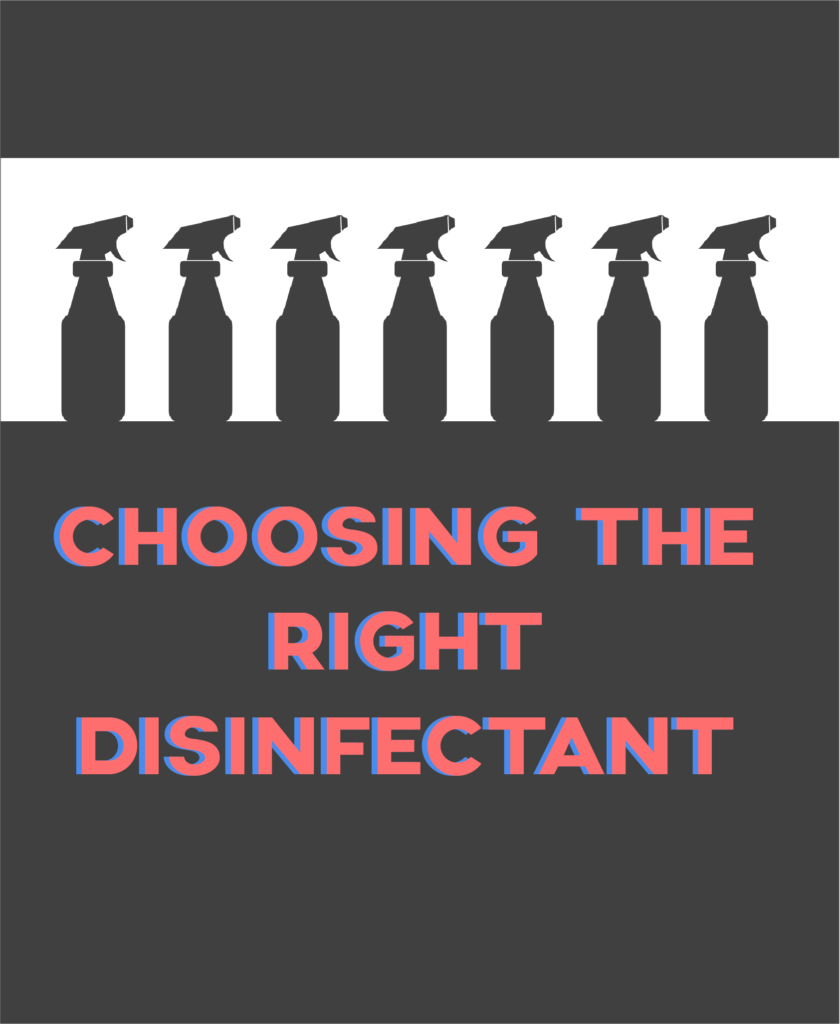How Do I Choose the Right Disinfectant?
Looking for the right disinfectant for your research or healthcare facility?
Trying to determine how to choose the right disinfectant for research or life sciences? Looking for the right disinfectant for a vivarium or lab? When choosing a disinfectant or sterilant for your laboratory, it’s important to understand the attributes of each individual disinfectant, as well as any compatibility issues and environmental concerns that accompany it.
The disinfectant you choose will need to kill the bacteria or viruses you’re concerned about, be compatible with the surfaces in your lab and work within a reasonable amount of time and with a reasonable amount of effort. Here are the six most important things to keep in mind when purchasing a new laboratory disinfectant.
Efficacy Claims
Often known as “kill claims,” efficacy claims are the roadmap to the species of pathogens that a particular disinfectant kills. This list of bacteria, viruses and spores provides an overview of which pathogenic agents your new disinfectant protects against. These claims are monitored and approved by the EPA, and each disinfectant must undergo rigorous testing in order to have a kill claim on its label. Not every disinfectant type is ideal for every kill, (EG: Alcohols are not effective against bacterial spores and non-enveloped viruses, and bleach and iodine can be deactivated by organic debris.) Knowing your disinfectant’s limitations means knowing whether it will be effective in your facility.

Contact Times
When deciding between two or three laboratory disinfectants, one aspect to keep in mind is the contact or “dwell” time, or the time that the surface must remain wet in order to achieve the desired kill. If room turnover, or employee time, is a great concern, then you’ll need a disinfectant that can achieve a fast kill. If a lab disinfectant requires too many applications over a period of time, you increase the risk that staff won’t remain diligent about rewetting, and increase the risk of pathogen spread. Studies have shown that when many disinfectants aren’t allowed to remain wet for the full contact time, efficacy suffers.
While short contact times are ideal, be careful: some lab and vivarium disinfectants with extremely short contact times (such as those that use alcohol as an active ingredient) can create more wear and tear on your surfaces, increasing the risk of pits and cracks that future bacteria can hide in.
One other aspect to consider when reviewing contact times is whether the disinfectant must be rinsed from the surface. Many modern disinfectants require no wiping or rinsing and thus save disinfection time.
How Safe is it?
Choosing the right disinfectant means reviewing the solution for safety characteristics. You can find all the information about the safety of your disinfectants in the corresponding Safety Data Sheet (SDS) (previously known as Material Safety Data Sheet, or MSDS.) Your disinfectant manufacturer should provide an easy way to view and download these data sheets so that if one is lost you can easily get another. At Quip Labs, for example, we provide an SDS Quick Access, which allows customers to easily sort by product and view online.
Evaluating a disinfectant for end-user safety and for direct or indirect contact with animals is extremely critical to ensure that the disinfectant is being used properly. When considering end-user safety, review the SDS sheet to understand any health ramifications that the disinfectant may have, taking care to note how often the disinfectant will be used and which PPE is required for end-users.
Additionally, you’ll need to check whether the disinfectant is safe for use around animals, either directly or indirectly. When used in research applications, a disinfectant is only useful if it doesn’t cause health complications to your research models. Is the disinfectant safe when left to dry on its own? Does it need to be rinsed? Does it need to be thoroughly cleaned? These are all questions that can affect whether or not your disinfectant works for you.
Ease of Use
Another important attribute of a disinfectant is its ease of use. Ready-to-Use products are easier to use than products that must be mixed, however, they can be more expensive. Better still is to purchase a proportioning system and tank which can measure out the correct amount of disinfectant without any additional effort from employees, or rely on CLO2 Disinfectants that can be mixed by simply dropping a tablet into a prefilled bottle of water.
Cost
Cost is often the first thing considered by facility managers and decision-makers, however, cost can be measured in several different ways. When factoring cost, it’s important to consider the amount of disinfectant needed, the efficacy of the disinfectant (after all, wasted research models can just as easily add to cost as upfront disinfectant purchases), shipping costs, the time that employees must spend on disinfection and the actual cost per ounce (not per bottle) of the disinfectant.
Back-end Support
Just as important as cost is the amount of back-end support you’ll receive from your disinfectant manufacturer. Can they answer any questions that may come up when using the disinfectant? Often this question comes down to their role. Are they just a supplier? Do they formulate the disinfectant themselves? Do they provide other facility hygiene solutions such as environmental monitoring and pathogen detection? Do they provide on-site training and support? Asking these questions up front can save a lot of hassle later.
